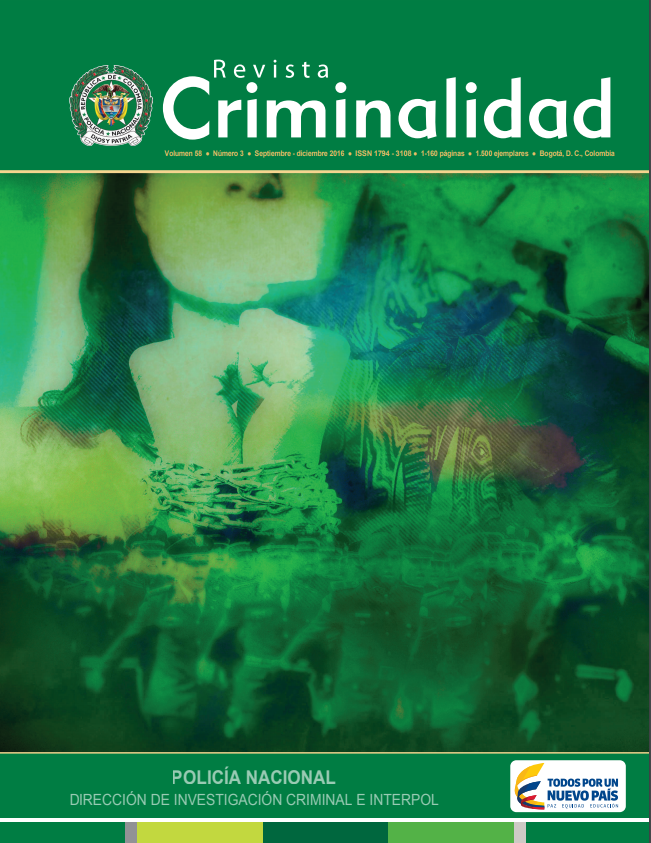The perception of fear in Mexico: variables contributing to its explanation in Yucatan and Guerrero
DOI:
https://doi.org/10.47741/17943108.103Keywords:
victimization surveys, fear, crime, crime prevention, the criminality factorsAbstract
Behavioral change due to fear of crime is also known as the perception of fear, and it has been determined that different variables -such as victimization, street lighting and trust in local authorities, for example- have a significant influence. This work is attempted to determine what variables can be useful to explain the perception of fear in both Mexican States, Guerrero and Yucatan, as well as the potential existence of explanatory models typical of each State. Method: By means of the database of the National Survey on Victimization and Perception about Public Security (“Encuesta Nacional de Victimizacion y Percepción sobre Seguridad Publica 2013 (n=5, 539), a lineal regression model was carried out using ten variables to determine which of them help explain the perception of fear in both States. Results: it was established that some of them, likeillegal sales of alcohol for example, do not help explaining the perception of fear, and that those variables that do have a significant influence are safety and security in the neighborhood, risk perception, and the number of activities carried out by the authorities. Likewise, clarifying variables typical of each federative entities were identified. Discussion: implications of the findings reported are addressed and recommendations given so that results may be used in the planning of prevention programs based on evidence.
Downloads
References
Averdijk, M. (2011). Reciprocal effects of victimization and routine activities. Journal of Quantitative Criminology, 27 (2): 125-149.
Box S., Hale, C. & Andrews, G. (1988). Explaining fear of crime. British Journal of Criminology, 28 (3): 340-356.
Brown, B. B., Werner, C. M., Smith, K. R., Tribby, C. P. & Miller, H. J. (2014). Physical activity mediates the relationship between perceived crime safety and obesity. Preventive Medicine, 66: 140-144.
Brunton-Smith, I. & Sturgis, P. (2011). Do neighborhoods generate fear of crime? An empirical test using the British Crime Survey. Criminology, 49 (2): 331-369.
Callanan, V. J. (2012). Media consumption, perceptions of crime risk and fear of crime: Examining race/ethnic differences. Sociological Perspectives, 55 (1): 93-115.
Cordner, G. (2010). Reducing Fear of Crime: Strategies for Police. U.S.: Department of Justice, Office of Community Oriented Policing Services (COPS).
Espinosa, V. & Rubin, D. B. (2015). Did the military interventions in the Mexican drug war increase violence? The American Statistician, 69 (1): 17-27.
Ferraro, K. (1995). Fear of Crime: Interpreting Victimization Risk. Albany: State University of New York Press.
Focás, B. M. (2015). Miedo al delito: los medios de comunicación, una dimensión explicativa. Apuntes de Investigación del CECYP (26): 191- 202.
Foster, S., Giles-Corti, B. & Knuiman, M. (2012). Does fear of crime discourage walkers? A social- ecological exploration of fear as a deterrent to walking. Environment and Behavior, 46 (6): 698-717.
Gainey, R., Alper, M. & Chappell, A. T. (2011). Fear of crime revisited: Examining the direct and indirect effects of disorder, risk perception, and social capital. American Journal of Criminal Justice, 36 (2): 120-137.
Gill, C., Weisburd, D., Telep, C. W., Vitter, Z. & Bennett, T. (2014). Community-oriented policing to reduce crime, disorder and fear and increase satisfaction and legitimacy among citizens: A systematic review. Journal of Experimental Criminology, 10 (4): 399-428.
Greenwood, P. W. & Welsh, B. C. (2012). Promoting Evidence-Based Practice in Delinquency Prevention at the State Level. Criminology & Public Policy, 11 (3): 493-513.
Guerrero Velasco, R., Gutiérrez Martínez, M. I., Fandiño-Losada, A. & Cardona, S. (2012). Sistema de indicadores comparables de convivencia y seguridad ciudadana: un consenso de países. Revista Panamericana de Salud Pública, 31 (3): 253-259.
Hanslmaier, M. (2013). Crime, fear and subjective well-being: How victimization and street crime affect fear and life satisfaction. European Journal of Criminology, 10 (5): 515-533.
Hilbe, J. (2014). Modeling Count Data. Nueva York: Cambridge University Press.
Instituto Nacional de Estadística y Geografía (2013). Encuesta Nacional de Victimización y Percepción sobre Seguridad Pública (ENVIPE). México: INEGI.
Keane, C. (1998). Evaluating the influence of fear of crime as an environmental mobility restriction women's routine activities. Environment and Behavior, 30 (1): 60-74.
Kimbro, R. T., Brooks-Gunn, J. & McLanahan, S. (2011). Young children in urban areas: Links among neighborhood characteristics, weight status, outdoor play, and television watching. Social Science & Medicine, 72 (5): 668-676.
Knight, C. (2010). Field surveys of the effect of lamp spectrum on the perception of safety and comfort at night. Lighting Research and Technology, 42 (3): 313-329.
Leenen, I. & Cervantes-Trejo, A. (2014). Temporal and geographic trends in homicide and suicide in Mexico, from 1998 through 2012. Aggression and Violent Behavior, 19: 699-707.
Liska, A. E., Sanchirico, A. & Reed, M. D. (1998). Fear of Crime as a Social Fact. Social Forces, 60: 760-770.
Lorenc, T., Clayton, S., Neary, D., Whitehead, M., Petticrew, M., Thomson, H., Cummins, S., Sowden, A. & Renton, A. (2012). Crime, fear of crime, environment, and mental health and wellbeing: Mapping review of theories and causal pathways. Health & Place, 18 (4): 757-765.
Lorenc, T., Petticrew, M., Whitehead, M., Neary, D., Clayton, S., Wright, K., Thomson, H., Cummins, S., Sowden, A. & Renton, A. (2013). Environmental interventions to reduce fear of crime: Systematic review of effectiveness. Systematic Reviews, 2 (1): 2-30.
McDonald, N. C., Deakin, E. & Aalborg, A. E. (2010). Influence of the social environment on children's school travel. Preventive Medicine, 50: S65-S68.
Mesch, G. S. (2000). Perceptions of risk, lifestyle activities, and fear of crime. Deviant Behavior, 21 (1): 47-62.
Molina-Jácome, I. (2014). Miedo al crimen y medios de comunicación: una revisión de la literatura. Revista Criminalidad, 56 (3): 9-23.
Moore, J. B., Jilcott, S. B., Shores, K. A., Evenson, K. R., Brownson, R. C. & Novick, L. F. (2010). A qualitative examination of perceived barriers and facilitators of physical activity for urban and rural youth. Health Education Research, 25 (2): 355-367.
Observatorio Nacional Ciudadano (2013). Estudio sobre los 5 delitos de alto impacto: enero 2012-abril 2013. México: Observatorio Nacional Ciudadano. Recuperado de: http://onc.org.mx/wp-content/uploads/2013/07/Estudio-Sobre-los-5-delitos-de-alto-impacto-Final.pdf
Panter, J. R., Jones, A. P., Van Sluijs, E. M. & Griffin, S. J. (2010). Neighborhood, route, and school environments and children's active commuting. American Journal of Preventive Medicine, 38 (3): 268-278.
Randa, R. & Wilcox, P. (2010). School disorder, victimization, and general v. place-specific student avoidance. Journal of Criminal Justice, 38 (5): 854-861.
Russo, S., Roccato, M. & Vieno, A. (2013). Criminal victimization and crime risk perception: A multilevel longitudinal study. Social Indicators Research, 112 (3): 535-548.
Skogan, W. (1986). Fear of Crime and Neighborhood Change. Crime and Justice, 8: 203-229.
Stodolska, M., Shinew, K. J., Acevedo, J. C. & Roman, C. G. (2013). "I Was Born in the Hood": Fear of Crime, Outdoor Recreation and Physical Activity Among Mexican-American Urban Adolescents. Leisure Sciences, 35 (1): 1-15.
Tang, W., He, H. & Tu, X. M. (2012). Applied categorical and count data analysis. Florida: CRC Press.
Téllez Acosta, W. J. (2015). Reforzamiento de la seguridad del hogar por miedo al crimen e incivilización social. Estudio de caso en una comunidad políticamente polarizada en Caracas, Venezuela. Revista Criminalidad, 57 (1): 91-102.
Vilalta Perdomo, C. J. (2012). Los determinantes de la percepción de inseguridad frente al delito en México. Inter-American Development Bank.
Visser, M., Scholte, M. & Scheepers, P. (2013). Fear of crime and feelings of unsafety in European countries: Macro and micro explanations in cross-national perspective. The Sociological Quarterly, 54 (2): 278-301.
Weisberg, S. (2014). Applied Linear Regression (4th Ed.). New Jersey: John Wiley & Sons.
Welsh, B. C. & Farrington, D. P. (2012). Science, politics, and crime prevention: Toward a new crime policy. Journal of Criminal Justice, 40 (2): 128-133.
Published
How to Cite
Issue
Section
License
Licencia creative commons CC BY NC ND https://creativecommons.org/licenses/by-nc-nd/2.0/















